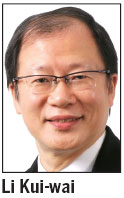MTR fare adjustment rides the chicken and egg inflation line
Updated: 2013-04-25 05:34
By Li Kui-wai(HK Edition)
|
|||||||
The fare adjustment for the MTR Corporation has at last been announced, though the adjustment of 2.7 percent is lower than the 5.4 percent of 2012. The result was based on the fare adjustment mechanism (FAM), which was initiated at a time of deflation some years ago. The FAM formula shows that the overall fare adjustment rate is equal to half of both changes in the consumer price index and wage index, less the productivity factor. At best, this is a convenient formula but may not be fair, nor has it taken into account the affordability of the general public.
None of the three aspects of the FAM formula can be controlled by the public. The first aspect, the consumer price index is a measure of general inflation that increases in all situations. The wage index also rises, though the rise can be slow. Even though the impact of these two factors is halved in the FAM formula, there is a sure guarantee that the fare adjustment will most likely be positive. The third factor, productivity, is unclear, but is definitely one that could be controlled by the MTR. The FAM definitely works to the advantage of the MTR, even though the government is the largest shareholder.
One has to remember that the FAM was constructed at a time of economic recession when the public was eager to see a downward adjustment in fare prices. However, Hong Kong's economy has experienced more years of inflation than deflation. If there is sustained and continued inflation, the FAM will rise in price every year. The question then is whether the FAM responds to price inflation or perpetuates an inflationary situation. Usually, price increases are adjusted to cover inflation movements. Such inflation-adjusted price increases apply to transport fares, the wages of civil servants and other pay adjustments. But equally, these adjustments bring about inflation the following year. Hence, the FAM perpetuates inflation. Deflation or a downward revision of the FAM would be unlikely unless there is another major economic crisis or recession.

The FAM has to be revised at an appropriate time. If the three components are to be kept, one improvement is to ensure inflation will not be prolonged. For example, a cap on the number of price increase years could be imposed on the formula. Fare increases can take place once every 2 or 3 years. Or the fare adjustment would be stabilized and capped to a small percentage over a number of years. The economics is that while fares are supposed to adjust to inflation, the subsequent fare adjustment would self-fulfill inflation. It would then become a chicken and egg problem and inflation could become uncontrollable. In other words, the formula shall limit the downside of a possible inflationary syndrome. This should be the responsible role the government has to play as a balance between stability and profit making is needed.
As the MTR in Hong Kong is basically a monopoly, it is quite sure the MTR will profit every year. The issue is not the possibility of any loss, but the size of the profit. Simple economics says that revenue is the product of price and demand. How can the profit of the MTR fall when price increases are guaranteed by the FAM formula and demand rises as tourists and travelers use the system constantly?
One could agree that the MTR has adopted a wise price strategy, one which provides a reward in "kind" rather than in "cash". Rewards in cash such as across-the-board fare reductions will benefit all users. Rewards in kind would be rewards given to some targeted groups. One provision this year has been a bulk purchase of a coupon that allows the users to have a fixed number of rides within a certain range that covers mainly the urban areas.
More rewards can be constructed. The MTR can go further by providing a "point to point" monthly pass that allows users to travel between two fixed points for work purposes. This will have advantages for users living far from urban areas, and a penalty or extra charge will be imposed if the user travels away from the stations within the two points. With the certainty of large profit every year, the MTR should not be stingy and should have a wider role in providing more economical usage of its transport system, especially for daily commuters.
The author is an associate professor in the Department of Economics and Finance at City University of Hong Kong.
(HK Edition 04/25/2013 page9)